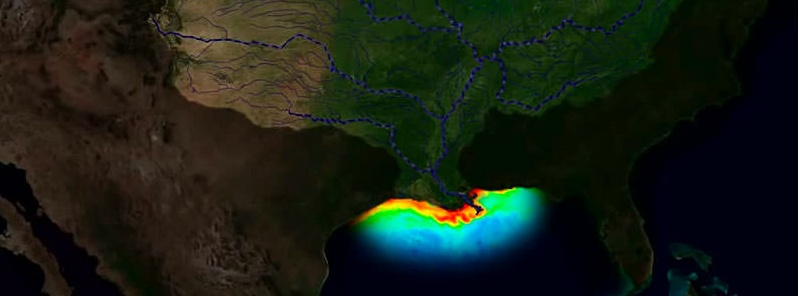NOAA predicts very large 2019 dead zone for the Gulf of Mexico

NOAA scientists are forecasting 2019 Gulf of Mexico hypoxic zone, or dead zone, to be very large – approximately 20 277 km2 (7 829 mi2). Dead zones are areas of low to no oxygen that can kill fish and other marine animals. Considered one of the world’s largest, the Gulf of Mexico dead zone occurs every summer, but this year's is expected to be close to record size.
A major factor contributing to the large dead zone this year is the abnormally high amount of spring rainfall in many parts of the Mississippi River watershed, which led to record high river flows and much larger nutrient loading to the Gulf of Mexico.
This past May, discharge in the Mississippi and Atchafalaya rivers was about 67% above the long-term average between 1980 and 2018.
USGS estimates that this larger-than average river discharge carried 156 000 metric tons of nitrate and 25 300 metric tons of phosphorus into the Gulf of Mexico in May alone.
These nitrate loads were about 18% above the long-term average, and phosphorus loads were about 49% above the long-term average.

The 2019 forecast is close to the record size of 22 729 km2 (8 776 mi2) set in 2017 and larger than the 5-year average measured size of 14 944 km2 (5 770 mi2).
The annually recurring Gulf of Mexico hypoxic zone is primarily caused by excess nutrient pollution from human activities, such as urbanization and agriculture, occurring throughout the Mississippi River watershed. Once the excess nutrients reach the Gulf they stimulate an overgrowth of algae, which eventually die, then sink and decompose in the water.
The resulting low oxygen levels near the bottom are insufficient to support most marine life and have long-term impacts to living marine resources that are unable to leave the area.
A NOAA-supported monitoring survey will confirm the size of the 2019 Gulf dead zone in early August, a key test of the accuracy of the models.
Featured image credit: NOAA

Commenting rules and guidelines
We value the thoughts and opinions of our readers and welcome healthy discussions on our website. In order to maintain a respectful and positive community, we ask that all commenters follow these rules:
We reserve the right to remove any comments that violate these rules. By commenting on our website, you agree to abide by these guidelines. Thank you for helping to create a positive and welcoming environment for all.